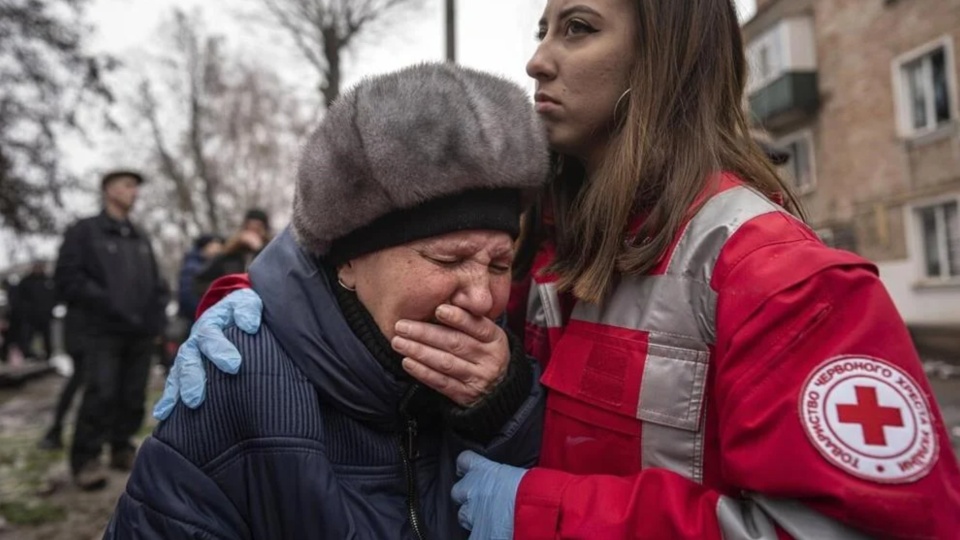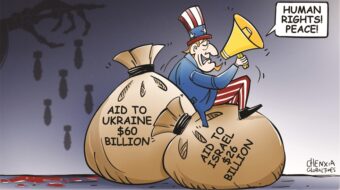
Very few, if any, of the lofty goals laid out by the Biden administration when it began to pour billions of dollars of weapons into Ukraine after the Russian invasion have been met.
The sophisticated U.S. arms the public was told would enable Ukraine to win the war have led not to victory but instead to what we see today: Ukrainians being sent on suicide missions in an attempt to shore up their failing counteroffensive. Death tolls of both Ukrainians and Russians are in the hundreds of thousands.
Here at home, the progressive aspects of Biden’s domestic agenda are in danger as the tens of billions of dollars spent on the war in Ukraine and the rest of the trillion-dollar military budget drain funds badly needed in U.S. communities.
Although there are still plenty of deadly weapons that are slated for Ukraine until at least next June, the public, both in the U.S. and European countries, is hearing stories about rampant corruption in Ukraine and asking how the aid is being spent.
Ukrainian President Volodymyr Zelensky did not help matters when he recently told U.S. reporters that he could not reveal what his country would do with the additional $60 billion now requested by Biden. Republicans have walked right into the door he and Biden left open to demand “accountability,” and they are holding up the U.S. aid just as the counteroffensive has been declared almost dead.

They are also demanding draconian right-wing changes to U.S. policy on the border with Mexico in exchange for approving any additional military aid to Ukraine—some of which Biden has signaled he may be open to.
Dead Ukrainians, dead Russians, fracking from one end of America to the other, and higher profits than ever for the fossil fuel companies and arms makers are the results of U.S. military aid to Ukraine so far.
The stalemate on the eastern front in Ukraine is actually a horror story worse than anyone would have imagined almost two years ago when the Russians first invaded. Ukrainian troops report that they are being sent on “suicide” missions in Kherson, for example, as their commanders dispatch them in a futile effort to establish a bridgehead on the Russian-controlled side of the Dnieper River.
Without using their names, they tell reporters that dead Ukrainians have been lying for months in the mud along the shores of the river and say the government is lying about the “progress” that is not being made.
“We spend all night in the water, and in the day time we watch as our comrades are killed all around us,” one soldier told the New York Times this week. “Yet the government says we are making progress. It is not true.” The soldiers told reporters they are under constant shelling, something not mentioned by a Ukrainian government desperate to show victories where there are none in order to qualify for more American “aid.”
Aside from assuring a military victory for Ukraine, Americans were told that another result of the shipping U.S. military hardware to Kiev would be the preservation of Ukraine as a “democracy,” standing against Russia, the “imperialist autocracy.”
Setting aside for a moment the descriptions of Putin that all Americans have heard, it pays to also examine what is going on in Ukraine when it comes to the question of democracy.
For the most part, major media in the U.S. have minimized things like the banning of most political parties in Ukraine, the shutdown of all newspapers except one government publication, the establishment of only one state-controlled television news station, the banning of the Russian language spoken by 35% of the population, cancellation of the coming elections, the murder of the former head of the country’s socialist party, and the disappearing of leaders of the Communist Party of Ukraine.
Sometimes the attacks on democracy in Ukraine are so severe, however, that even the New York Times can’t ignore them. This week, that publication reported how soldiers are snatching people off the streets all over the country, forcing them into conscription.
People with both physical and mental disabilities, certified as draft exempt, are being forced into cars by army recruiters and driven to places where they are beaten and otherwise abused until they agree to join the army. Disabled people have also been shipped to the front lines, where some have died.
Hundreds of families are in court trying to stop the attacks by army recruiters, but lawyers and activists say the government defends the actions, using the excuse that the country is under martial law.
Many of the out-of-control conscription operations were actually set up with Zelensky’s approval after he recently fired many older recruiters who were not getting satisfactory results. Some were also accepting or demanding huge bribes in the thousands of dollars to grant those with cash an exemption from military service.
In the beginning of the war, there were more volunteers, but increasingly the Ukrainian public is growing tired of war and deprivation and want nothing more than peace. Anti-war demonstrations are illegal in Ukraine, however, just as they are in Russia. Even calling for negotiations to end the war can lead to arrest and jailing as a “traitor” in Ukraine.
The Biden policy to improve democracy’s chances in the region involves U.S. collaboration with the exact opposite of pro-democracy forces, among them right-wing nationalist and even fascist elements in several countries. In particular, Latvia and the other Baltic states, Lithuania and Estonia, are run by extreme nationalist anti-Russian right wingers.
In Latvia, as much as 40% of the country is Russian-speaking, with tens of thousands of those people having been born in Latvia more than 40 and 50 years ago when the country was part of the Soviet Union. The right-wing nationalist government in Latvia has been sending out notices to thousands of these people that they must evacuate the country by the end of this year.
Stripped of their citizenship, pensions, and rights, they are being left with nowhere to go. There are bans on history books that tell about Nazi concentration camps set up in Latvia and laws that require Russian speakers to speak Latvian instead.
Just as the U.S. was aligned with Ukraine as it persecuted Russian speakers in Ukraine for so many years, it is now similarly aligned with Baltic countries doing the same thing. The entire situation is particularly tragic when one considers that during the days of the Soviet Union and socialism, Russians, Ukrainians, Latvians, and Lithuanians worked together to successfully defeat the Nazis who occupied all their countries.
The other—and perhaps the most important—result of Biden administration policy in Ukraine was supposed to be the use of that war to defeat and permanently weaken Russia without the U.S. military ever having to get directly involved in the war.
That projected result has also more than failed, with Russia today actually displaying what the New York Times called recently a “robust consumer economy.”
When the Russians first invaded Ukraine, Zelensky urged all Western companies to vacate Russia. “Don’t let them see a penny of your business,” he said, and many began moving out. In addition, the U.S. imposed what it said would be “crippling” sanctions, with Biden even bragging that the exodus of U.S. companies would destroy the Russian economy.
Nothing of the kind happened, though, because what U.S. businessmen did not count on was a fightback from the Russian side. Large companies were nationalized by the Russian government, and smaller ones were forced to sell at low prices to people connected to Putin and his ruling circle. This forced many who wanted to leave to rethink their decision; several opted to maintain their operations in Russia.
If a company wanted to leave, the Russian government imposed heavy capital flight taxes—something the U.S. government should emulate, by the way, to keep big companies from fleeing overseas for cheaper labor. The companies that pursued leaving Russia lost well over $100 billion in profits, according to estimates in the Times.
Companies that wanted to leave were also forced to compensate their workers for wages lost, making Putin and the government popular in the eyes of the many thousands of people employed by these companies.
Huge companies like Toyota, Ikea, and others were taken over by the state. Consumers often ended up getting better prices from the state-owned versions of Toyota and Ikea than they did when they were privately owned.

The Krispy Kreme doughnut chain became Krunchy Dream; Starbucks stores were rebranded Stars Coffee. Pepsi, supposedly pulled from the Russian market, still sits on supermarket shelves, as the popular drink is now imported from Kazakhstan. Muscovites who prefer Coca-Cola also don’t have to worry, as there are regular supplies arriving from Poland.
Again, workers in all these companies kept their jobs and were not particularly unhappy about getting paid more than they did before. Putin, of course, used all of these developments to deflect attacks on him as a killer and an autocrat. People falling out of windows or being poisoned were not the first concern for citizens who see Putin as saving their jobs and standing up to their old corporate bosses and the “West.”
It’s true that the nationalizations and forced sales have made international companies much more reluctant about ever investing in Russia again, but regardless of all that, the U.S. sanctions touted by Biden have, at least for now, largely failed and even backfired.
Here at home, we have to worry about what, for us, may end up as the biggest failure of the U.S. war policy in Ukraine and elsewhere around the world. If the Biden administration does not change course and move convincingly in the direction of peace, it jeopardizes not only its progressive domestic policies but also risks opening the door for a victory by the Republicans in 2024.
A MAGA victory, with or without Trump, would be a disaster for everyone.
As with all op-eds published by People’s World, this article reflects the views of its author.
We hope you appreciated this article. At People’s World, we believe news and information should be free and accessible to all, but we need your help. Our journalism is free of corporate influence and paywalls because we are totally reader-supported. Only you, our readers and supporters, make this possible. If you enjoy reading People’s World and the stories we bring you, please support our work by donating or becoming a monthly sustainer today. Thank you!

MOST POPULAR TODAY

Columbia students and supporters expose the lies about the campus uprising

After Bolivia, Elon Musk says capitalists can overthrow any government they want


Leaked N.Y. Times memo reveals biased pro-Israel coverage of Gaza war

On Workers’ Memorial Day, AFL-CIO’s Shuler says workers still pay “ultimate price”






Comments